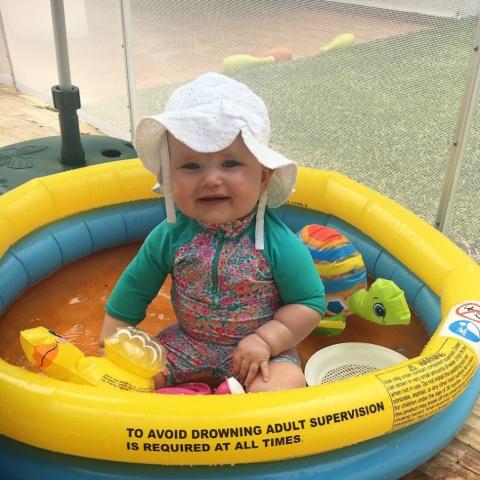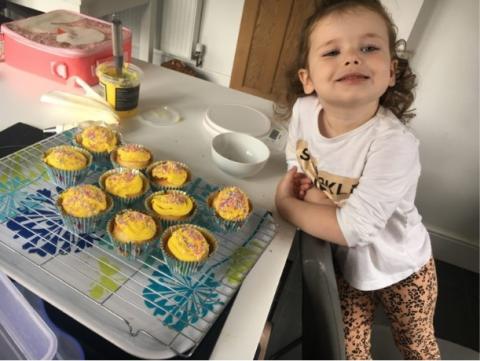
Hi, I’m Gemma and here’s my take on introducing foods to my daughter Amelie.
I think it’s safe to say that we got most of our advice and support from our dietitian on this important milestone. I spoke briefly to the Health Visitor about it but they steered away from offering any advice really other than recommending baby led weaning from 6 months.
REDUCING BREASTFEEDING
I do remember feeling a little apprehensive about introducing food as it felt like we’d ‘cracked’ the breastfeeding and phe-free formula. That said we went for it when Amelie was around 5 ½ months. I’d made the decision to stop breastfeeding and spoken to the dietitian about the next steps. We started with ‘free’ foods and Amelie’s first food was banana which she loved!
We introduced simple flavours to begin with and we tried to prepare as many of our own purees as possible, but we did buy some readymade vegetable and fruit pouches for ease. As she got used to eating we started with around 10g of a spoonable protein substitute. We were worried she wouldn’t take to it but she surprised us all and took it really well. As I reduced the breastmilk we were able to introduce phe exchanges such as yogurt and vegetables to make up her protein allowance.
We didn’t really feel able to adopt a baby led weaning approach as we needed to ensure that protein exchanges were consumed, and we had to give her the protein substitute. Although I did try to encourage it with free/low protein finger foods such as fruit, crackers and toast, Amelie would prefer being fed by us as she’d got used to us feeding her the protein substitute and exchanges.

FOCUSING ON FREE/LOW PROTEIN FOODS
Overall introducing foods and the new protein substitute wasn’t actually as stressful as we’d thought it would be, Amelie adapted really quickly and was willing to try different foods. As she got older and hungrier, we did keep meals simple though and I would cook things like vegetable stews, soups, low protein sausages, pasta and bread.
Preparation and batching food was key, as well as getting a good size freezer! Amelie has been on 4 exchanges for as long as we can remember and as she has classic PKU we know this won’t change massively even as she gets older, so it’s been really important for us to focus on the free/low protein foods.
SICKNESS AND TEETHING
Having said that, we were lulled into a false sense of security as within a couple of months we were hit with sickness and teething… I vividly recall sitting on the kitchen floor with vomit all over us knowing we were going to have to try and give Amelie more protein substitute to replace what she had thrown up.
Teething caused sore gums and grumpiness, and we saw a shift in her appetite and excitement towards eating. I guess this is a familiar scenario to most parents but we had to ensure she had her protein substitute. To overcome this tougher time we got a lot of advice from the dietician and used various techniques such as distraction tactics and syringing the protein substitute in to avoid her sore gums.


HANDING OVER RESPONSIBILITY TO SECONDARY CAREGIVERS
Another challenge was handing over responsibility of Amelie’s diet while she was in others’ care… It wasn’t that we didn’t trust others to care for her; it was ensuring she had her protein substitute and exchanges and was eating the right foods. I found that providing all her food with ‘instructions’ to family and friends was the best way to relieve our anxieties and let go a little. Those looking after her also found this helpful as they initially felt anxious about getting it right.
Amelie joined nursery when she was 10 months old when I went back to work and I was also worried about handing over responsibility to them. However, we and the dietitian spent time with the staff to help them understand the condition and diet which made us feel more at ease. I have to say we’ve been really lucky that the nursery have embraced the condition and do so much to ensure Amelie’s diet has become the ‘norm’.
GOING OUT TO EAT WITH PKU
A big thing for us was venturing out to eat… wondering whether places would accommodate Amelie’s requirements or be difficult if we took her own food to eat. As our confidence grew and we became less conscious about it, we started to go out more often.
The recent vegan revolution has been amazing as a lot of restaurants offer vegan dishes which can be adapted! … We often go for ‘cappuccinos’ and Amelie has plant based milk which she loves! We plan in advance; I look at the menus online and call the restaurant if I need to.
Our favourite meal out is pizza and we take a pizza base which they top with vegan cheese and tomato – we bring any leftovers home and freeze them! We find that some places are more accommodating than others but we don’t let that put us off. Now she understands more, Amelie will happily explain she has PKU to restaurant staff!
TRANSITIONING TO A NEW PROTEIN SUBSTITUTE
Amelie doesn’t have a great appetite and I’d put that down to her being a normal 3 ½ year old but also having to take a protein substitute 3 times daily with meals may not help but this is essential.
We’re currently transitioning from a spoonable to a liquid protein substitute and we hope this will improve her appetite. It definitely feels like we’re coming out the other side – perseverance and positivity have been key!
